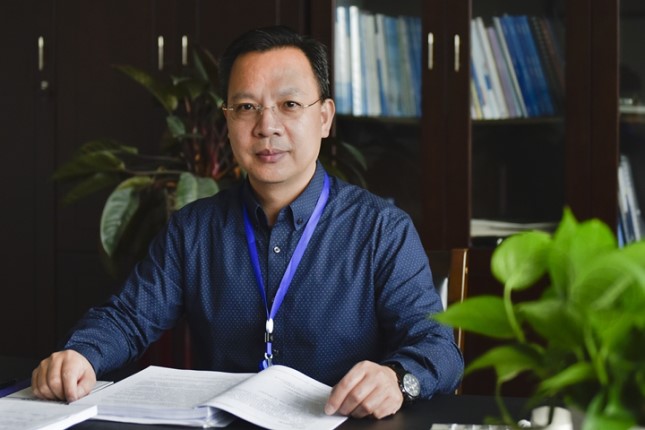In the China-made sci-fi blockbuster Wandering Earth II, humans use nuclear fusion to create great power to support the planetary engines. In the real world, how long it will be until efficient and clean power from fusion can be available for humans?
Duan Xuru, a senior expert on fusion who is also a member of the National Committee of the Chinese People's Political Consultative Conference, revealed in an exclusive interview with the Global Times that it will be about 30 years.
Fusion refers to the process where two atomic nuclei combine to form a heavier nucleus while releasing a large amount of energy. This process happens at any minute in the universe, especially inside the Sun. In the film, humans burn stones to cause process. As stones are much heavier than an atomic nucleus, such a process is called the fusion of heavy nucleus, Duan, chief expert on fusion of the Southwestern Institute of Physics under the China National Nuclear Corp (CNNC), explained.

Duan Xuru, chief expert on fusion of the Southwestern Institute of Physics under the China National Nuclear Corp. Photo: Courtesy of Duan.
"The fusion of heavy nucleus is not a focus of current research as it requires strict conditions to realize. For example, sizable fusion of light nucleus can happen when the temperature exceeds 100 million C, but the temperature required for fusion of heavy nucleus is far higher than 100 million C," Duan explained.
It is temporarily impossible for humans to build engines that are capable of using fusion to move the Earth like the film pictured. But, given the efforts of scientists, it can be expected that efficient and clean power from the fusion of light nucleus can be available for humans in the near future, according to Duan.
"The research and development of controllable nuclear fusion has gradually entered the stage of reactor engineering experiments from principle exploration and large-scale experiments. Now we have a clearer understanding of controllable nuclear fusion technology, especially the construction of the International Thermonuclear Experimental Reactor (ITER) project, which will soon make the first power plant-scale fusion reactors a reality," Duan said.
With the existing nuclear science and technology industrial system, it is believed that human beings can use controllable nuclear fusion energy in about 30 years, that is, by the middle of this century, Duan predicted.
China's controllable nuclear fusion research began as early as the 1950s, which was almost in sync with international controlled nuclear fusion research. In 2006, China, the EU, the US, Russia, Japan, South Korea and India jointly signed the ITER agreement, which is one of the largest and most far-reaching international scientific projects in the world. The project is also the largest international science and technology cooperation project in which China participates as an equal.
According to Duan, during the more than 10 years of participating in ITER, research on nuclear fusion in China has developed rapidly. Magnetic confinement nuclear fusion research has entered the stage of parallel running, and some technologies have reached the world-class level.
The construction of device platforms and the improvement of capacity in China, such as China's circulator manufacturers and the doughnut-shaped Experimental Advanced Superconducting Tokamak (EAST) reactor - one of three major tokamaks in operation in China, which is also called "artificial sun" because it mimics the nuclear fusion reaction that powers the real Sun - have realized leapfrog development in the country's magnetic confinement fusion, and led to continuous breakthroughs in physical experiments. It largely promoted the development of theory and large-scale numerical simulation, according to Duan.
In December 2020, the new generation of China's HL-2M tokamak, developed by the Southwestern Institute of Physics under the CNNC, realized its first discharge, laying a solid foundation for the next step of China's independent design and construction of fusion reactors.
A new breakthrough was made in October 2022 with its plasma current exceeding 1 million amperes, creating a new record for the operation of controllable nuclear fusion device in the country.
In November 2022, the Southwestern Institute of Physics also rolled out a core component of ITER, completing the production of the enhanced-heat-flux first wall panel of the project.
ITER is known as the world's largest "artificial sun." To meet the conditions of controllable nuclear fusion, the plasma inside it would be as hot as 100 million C, and the reaction process would produce a large amount of extremely high-energy particles. Thus the so-called first wall panel of the project, which is designed to have immediate contact with the plasma and particles of high temperature, is its "firewall," Duan explained.
The production of the enhanced-heat-flux first wall panel of the project with its performances substantially higher than design requirements proves that China has made a thorough breakthrough and keeps leading the way in the technology, Duan noted.
The next step of the "artificial sun" project is to gradually transit from the deuterium-tritium combustion experiment stage to the fusion reactor engineering and physical experiment stage, and finally realize the aim of building fusion power stations of demonstration and then the construction of commercial fusion power stations, according to Duan.
As a member of the 14th National Committee of the CPPCC, Duan proposed to set up a nuclear science day to enhance the public's understanding of nuclear knowledge.
He also suggested giving full play to the role of the nuclear technology and industrial system in promoting the high-quality development of the country's nuclear fusion energy research and development in order to attract more experienced professions into the field to accelerate the high-quality development of fusion-generated power, which would also contribute to the country's dual carbon goals of reaching peak carbon emissions before 2030 and achieving carbon neutrality before 2060.
Main photo: Promotional material for The Wandering Earth II © Courtesy of Maoyan.
Source: The Global Times.
































